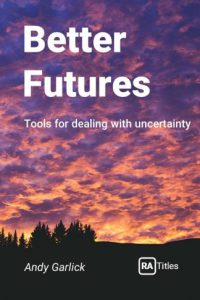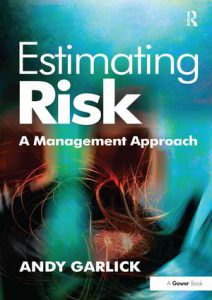As part of our mission to contribute to the advancement of good practice and help organisations adopt it The Risk Agenda is happy to make information and tools available. We hope our clients and others will be able to benefit from them. However we are conscious that the information we publish here goes out of date and we have removed links to various capability statements, CVs, product briefings and so on. What’s more we have published a couple of books to set out our thoughts – see below.
If you would like more information about the company and our ideas on risk modelling (and reviewing risk models), programme risk analysis, risk mapping and risk management please do get in touch with Andy using the contact page.
However we have kept our RiskBite feature to post new items of interest and have maintained the risk glossary and an overview of risk software. Both should stay reasonably current.
Quantitative Risk Analysis
A major feature of our work has involved quantitative modelling of risk. It forms the topic of one of books and we have also developed innovative tools for carrying out Monte Carlo calculations on relatively simple risk models. We are happy to make this tool available for use by others. If you are interested, please see our software page.
Books
We have written two books which put forward out ideas on risk management generally and quantitative risk modelling in particular.
 Better Futures: Tools for dealing with uncertainty is not just a textbook on risk management. It provides a new perspective to help you embed risk management into your organisation in a more natural way; the aim is to ensure you maximise your opportunity to enjoy ‘better futures’ rather than worse ones, taking account of the many facets of uncertainty you and your organisation face.
Better Futures: Tools for dealing with uncertainty is not just a textbook on risk management. It provides a new perspective to help you embed risk management into your organisation in a more natural way; the aim is to ensure you maximise your opportunity to enjoy ‘better futures’ rather than worse ones, taking account of the many facets of uncertainty you and your organisation face.
This book deconstructs every aspect of ‘common practice’ risk management and rebuilds it into a structure which is more logical and better adapted to embedding in organisations. It uses a single management model to examine three layers of risk management: how we do it naturally, how we recognise it in our processes and how we adopt it within formal governance.
This narrative emphasises the importance of an appropriate risk culture and the need to take account of the formal disciplines of decision and game theory. There are detailed chapters on both risk culture and decision making.

Estimating Risk: A management approach explores the role of quantitative techniques in modern risk management. Risk management has grown in importance in most organisations in the last 20 years, but in many remains simply a matter of processing lists of risks and actions. Andy argues that this fails to make the most of the techniques available and that organisations can improve their risk decision making by using risk models.
His book describes a broad range of modelling techniques, all illustrated with business-relevant examples. The role of the models in decision making is also discussed with particular emphasis on what the risk premium – the price people charge for taking risk – is and should be.
In order to provide a self-contained account the underpinning material from probability and decision theory is also included, so the book will provide a handy reference guide for all practitioners. The discussion is consistently informal and the book provides a critical view of the accepted wisdom in risk management. This book will enable managers and their specialist advisors to improve their approach to risk whilst removing the mystique.
Both these books are available on Amazon and the usual sites, but if you get in touch we will send you a payment link at 25% off the current price and dispatch your order promptly.

